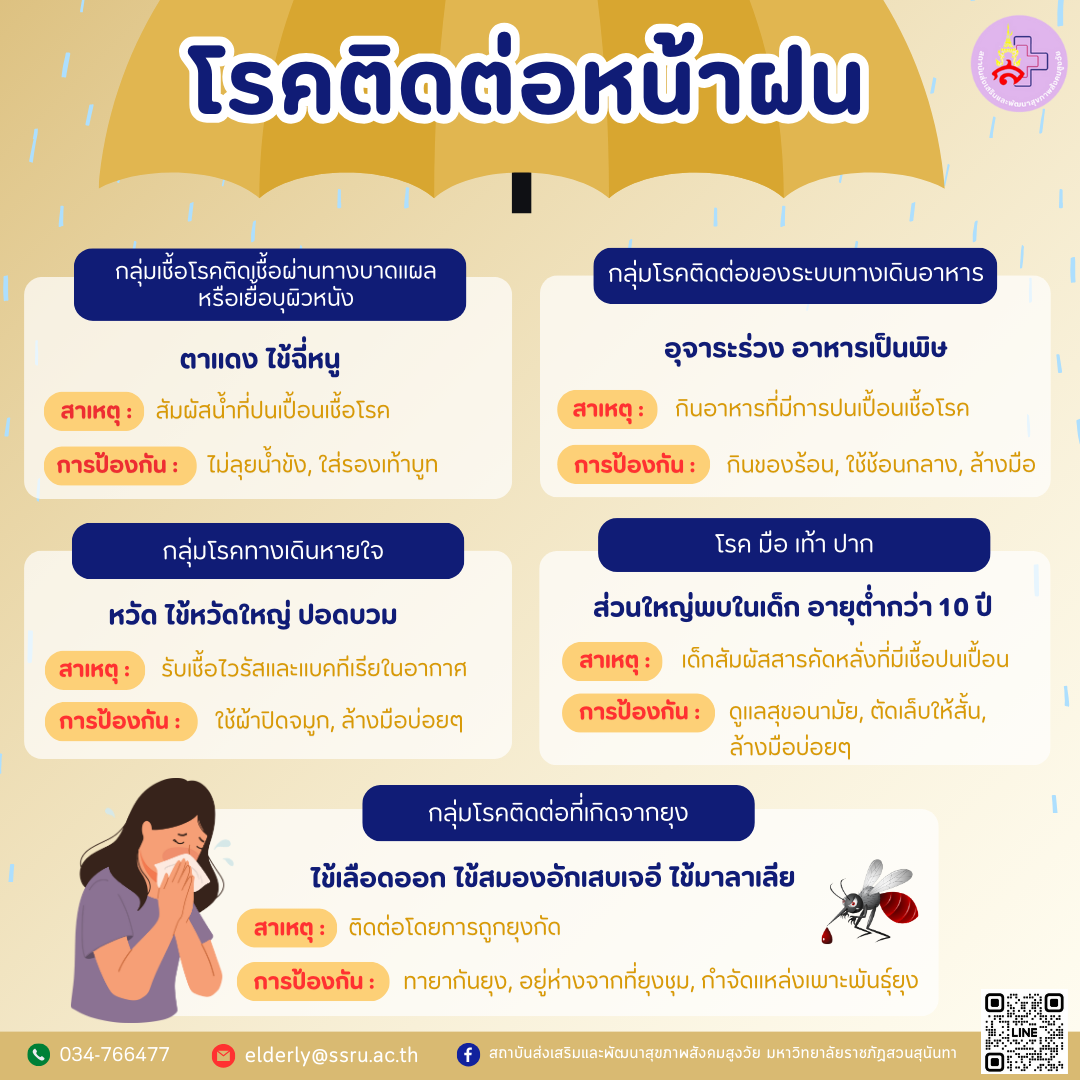
Communicable
diseases during rainy
season
1. Group of
germs that pass through wounds or
epithelial tissue
Laptospirosis, or
leptospirosis, symptoms include acute
high fever, headache, often severe
muscle pain in the calves and thighs,
and red eyes, approximately 5-10
percent. People with this disease may
have severe symptoms such as jaundice,
kidney failure, or shock. This disease
often occurs in areas that are flooded.
People who have a lot of rats in their
homes: farmers, gardeners, farm workers,
cattle, pigs, fish, people who work in
digging drainage pipes, mining,
slaughterhouses.
2. Group of
infectious diseases of the
gastrointestinal tract
Acute
diarrhea, dysentery, typhoid, food
poisoning. These diseases are caused by
eating foods that are contaminated with
microorganisms that cause disease in the
gastrointestinal tract in the
intestines. The patient will have
diarrhea. Watery diarrhea, may have
fever, pain in the stomach, and if
infected with dysentery there may be
mucus or blood in the stool. In
addition, hepatitis A and B viruses can
also be transmitted by eating
contaminated food. People with hepatitis
will have fever, fatigue, and jaundice.
Yellow eyes or jaundice Nausea and
vomiting Therefore, in this rainy
season, you should be especially careful
with the food you eat. By eating freshly
cooked, clean food using your own
spoon.
3. Respiratory system
disease group
Colds, influenza, strep
throat, bronchitis, pneumonia or
pneumonia. Especially at present there
is an outbreak of a new strain of
influenza, type A H1N1. which is a new
epidemic which is now found to be an
outbreak throughout the country and
avian influenza that has its source of
spread from poultry. The germs may
cross-breed with influenza strains in
people during the rainy season
outbreak.
4. Hand, foot, and
mouth disease
Caused by infection
with the human enteroviruses group. The
most common germs in this group are
Coxsackieviruses It is a disease that
frequently spreads during the rainy
season. The weather is cool and humid.
The most common risk groups are infants
and young children under 5 years of age.
Disease transmission: direct contact
with mucus, saliva, feces, fluid in
blisters or The patient's wound is
infected with the virus. or indirectly
from contact through toys, hands of the
owner, water and food that are
contaminated with germs Common symptoms
Patients often have a fever, sore mouth,
drooling, and sores in the mouth or
throat. There is a rash that looks like
clear fluid-filled blisters or red bumps
on the palms, soles of the feet, or
around the anus. Sometimes there may be
a rash on the body, arms, and legs.
There may be vomiting. Also diarrhea.
Most of the patients' symptoms are
usually mild. Able to recover on its own
The fever usually goes away in 2-3 days
and the rash improves over 7-10
days.
5. Group of 3 important
mosquito-borne diseases:
- Dengue
fever is carried by Aedes mosquitoes.
which is more than 80 percent It is a
mosquito that lives in homes and lays
eggs in water that is stuck in various
places. Patients in the early stages
will have symptoms similar to normal
viral infections, including fever and
body aches. There may be severe bone
pain. The fever will be high for about
2-7 days, after which the fever will
subside. Along with this, there may be
symptoms of abnormal bleeding, cold
hands and feet, or shock.
- JE
encephalitis (Japanese Encephalitis) has
annoying mosquitoes that carry the
disease. Often breeds in water sources
in rice fields. Patients will have a
fever, headache, and vomiting. After
that, they may become lethargic or have
seizures. The patient may die. or become
disabled if not treated
- Malaria is
carried by Anopheles mosquitoes in the
forest. The patient will have a high
fever, chills, and become pale due to
the breakdown of red blood cells. If it
is severe, there may be kidney failure,
hepatitis, lung abnormalities, and there
may be a brain disorder called Malaria
can enter the
brain.
Source:
Bangpakok 3 Hospital
